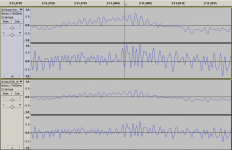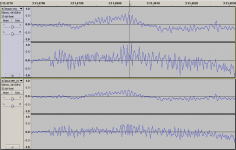Is there any music content in that "extra" signal? Or, is it all well above audibility?
I think the laptop A/D process would stop anything over 22.05kHz
I wondered too whether its just an artifact of the way its observed in Audacity.
OK, looks like a false alarm - so easy to get fooled by the reconstruction 'magic' at the output of the DAC. Resampled to 176.4kHz, so the waveform starts to look a lot more 'analogue', and the seeming artifact disappears ...

The problem "appeared" to be there because of the precise timing of very high frequency audio peaks:

The problem "appeared" to be there because of the precise timing of very high frequency audio peaks:
The problem "appeared" to be there because of the precise timing of very high frequency audio peaks:
That's it! And that's also the reason why I like 24bit files at high sampling rate, but they are soooo long .....
And, if you look at sample values only, without reconstruction low pass filter, it is really hard to tell ...
Yes, we didn't have the master file in the test. But once we did, even it sounds very much like the others.It may indicate to poor quality of the "direct" sound used for the test.
I listened to only the wav files. Their levels were very closely matched. Close enough, I would say. When I did my Mud Vs Wire test, level matching was difficult. I used tones at 150, 440, 5K to set levels before recording the samples. Even that required some minor tweaks in post to get perfect matching levels.If there is any similar test in future, I would suggest to use wav files for comparisons, exactly matched in level.
Agreed, but even on the best system I have, it's still hard to hear the difference. The Foobar ABX plugin is the best thing I know for solo blind testing. It will play the files simultaneously so that you can pop back and forth. Or you can play them sequentially if you like. Try going back and forth between A/B and be honest with yourself. Can you hear the difference? Then move on to ABX if you think you can.The people who are testing the samples should not use cheap PC motherboard soundchips and cheap headphones or plastic speakers
Its a Marantz Pearl-Lite SA-CD
Cool! No slouch there. I haven't heard one but it's closer to TOTL than BOTL.
My Blind Test Notes
When I looked again at my blind test notes, I feel it might be useful for future reference. Accuracy aside, it was a very honest perception because it is a blind test. There are other impressions that I didn't documented, such as when I found the music was so enjoyable or so terrible in the background, I checked my iPod and it was always associated with banana (direct) and satsuma (4558). Pomegranate is unique as it has special quality to the sound but perform terrible.
In the second picture you will find my final blind test regarding banana (direct) and orange (OPA134) to decide which one is best, because from the early blind test (picture one) Orange "outperformed" banana due to the soundstage, vocal and its ability to round the sharp ends (violin). After the final blind test between the two it was clear to me the superiority of the banana.
When I looked again at my blind test notes, I feel it might be useful for future reference. Accuracy aside, it was a very honest perception because it is a blind test. There are other impressions that I didn't documented, such as when I found the music was so enjoyable or so terrible in the background, I checked my iPod and it was always associated with banana (direct) and satsuma (4558). Pomegranate is unique as it has special quality to the sound but perform terrible.
In the second picture you will find my final blind test regarding banana (direct) and orange (OPA134) to decide which one is best, because from the early blind test (picture one) Orange "outperformed" banana due to the soundstage, vocal and its ability to round the sharp ends (violin). After the final blind test between the two it was clear to me the superiority of the banana.
Attachments
They do need a different approach in use. Not a straight swap by any means. I suppose the attraction would be if they had a "specific sound" that could be attributed to them, a "sound" that some like (in a way that say marks out a valve amp). Technically they have the ability to offer enhanced performance in some areas (speed... but then again how fast do you need), and in other areas perhaps less good than conventional devices.
"specific sound" that could be attributed to them, a "sound" that some like (in a way that say marks out a valve amp)
This is a very good remark. Interestingly enough, there are parts with a "specific sound" though you measure quite nothing with available methods. This has been keeping me surprised for at least 10 years
This is a very good remark. Interestingly enough, there are parts with a "specific sound" though you measure quite nothing with available methods. This has been keeping me surprised for at least 10 years
The age old problem
This is where the industry has stuffed up, big time. Obsessed with using conventional techniques for measuring things, it has made no progress in distinguishing parts and implementation techniques, which people with attuned hearing have no problem in separating, or grading. Hence the whole 'snake oil' industry, etc - it only has itself to blame ...This is a very good remark. Interestingly enough, there are parts with a "specific sound" though you measure quite nothing with available methods. This has been keeping me surprised for at least 10 years
Nothing surprising really, inflexibility in thinking has been with mankind since year dot ...
That's brilliant Jayand it really is the best way to do it.
The current feedback opamps (the LT1229) might be worth working with in future perhaps really optimising the circuitry to suit them.
Apparently my amps (MC2 Audio) use a current feedback driver stage, at least that is what their blurb says.
I always assumed that they use a cf opamp but I've never looked inside one.
They do need a different approach in use. Not a straight swap by any means. I suppose the attraction would be if they had a "specific sound" that could be attributed to them, a "sound" that some like (in a way that say marks out a valve amp). Technically they have the ability to offer enhanced performance in some areas (speed... but then again how fast do you need), and in other areas perhaps less good than conventional devices.
From my blind test notes, the chip performed very well with complex passage or high speed (and it's just a trio). Coz the other high slew rate opamps have similar tendency, I must state here that my notes regarding lm4562 ("what a terrible sound") was not addressed at music#4 (the trio). I just don't have the column for general impression there.
This might be used in the "marketing" of such opamp???
This is as good an example as any of the fact that putting high performance parts in a situation guarantees absolutely ... nothing - quite often it will make things worse! The word is balance, balance, balance ...Coz the other high slew rate opamps have similar tendency, I must state here that my notes regarding lm4562 ("what a terrible sound") was not addressed at music#4 (the trio).
Get a mediocre car, stick on the highest performance tyres you can buy - that will obviously turn it into a street dominator ...
- Home
- General Interest
- Everything Else
- ULTIMATE OPAMP SHOOTOUT... Where you get to decide.


